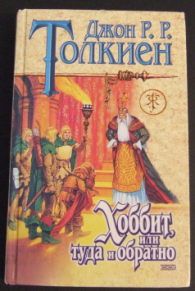Spellbound by Blake Charlton: A Review
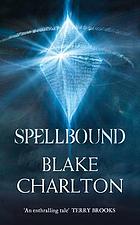
I have finally had a chance to read the sequel to Spellwright by Blake Charlton entitled Spellbound. 

 Â The plot takes place ten years after the events in the first volume, and Nicodemus Weal is on the run. The book introduces a new character, however, and she makes her appearance right from the beginning. The first line of the book, I’ll admit, had me hooked:
 The plot takes place ten years after the events in the first volume, and Nicodemus Weal is on the run. The book introduces a new character, however, and she makes her appearance right from the beginning. The first line of the book, I’ll admit, had me hooked:
Francesca did not realize she had used an indefinite pronoun until it began to kill her patient.
That imaginative wordplay and ingenious (yes, I’ll say it… ingenious) magic system of Charlton’s is back and better than ever:
Francesca used [the runes] in her left forearm to write a few silvery sentences that glowed on her skin. With her right hand, she pulled the spell free. It folded into a short, precise blade.
Spellbound also introduces a new order of magic-users: the hierophants or “wind mages” which use wind and cloth to wield their power. They cast spells slowly (beat by beat of their heart), and Charlton gives an intriguing description of the inner workings of one of their windcatchers:
Inside the windcatcher, hundreds of radial sails were arranged like windmill blades and rotated around a central point. Somehow a hierophant was suspended within the windcatcher. The many sails focused the energy of their rotation into the hierophant’s heart and accelerated its spellwriting. Each augmented heartbeat produced a hundred thousand times more runes that it otherwise would./ This was the hierophantic key to power. Their language was produced only in the heart muscle, was limited to cloth, and melted into a wind when cast. However, they had harnessed nature’s power, transformed the wind into words. From a school of kite-flying hermits on the slopes of Mount Spires, they had grown into the linguistic backbone of a powerful kingdom.
We also get to see much more of kobold culture. The kobolds, with “their midnight skin and blond hair”, can only cast spells in the darkness.
The lycanthropes are a new race of beings, and they prowl the savannah. There is an interesting twist to their role in the story, as well as an unexpected turn of events having to do with the Savannah Walker as well as a ghost that makes a debut.
Although the plot can get overly complicated sometimes, Charlton does a good job of pulling the reader along. His magic system, though, is what I most enjoyed from these two books (and expect from the promised third volume, Spellbreaker). With sentences like “An unseen wartext blasted the ghost’s right arm into a cloud of golden text”, how can anyone who loves language and how it works not be intrigued with making invisible words tangible and full of power.
In closing, I had the great good fortune to see Blake Charlton give a talk at the American Library Association Annual Conference last summer in Anaheim, CA. He was extremely entertaining but also poignant at times talking about growing up with dyslexia and “riding the short bus.” He would go on to medical school and prove everyone wrong that thought he wouldn’t amount to much. I also had the chance later that same day to talk briefly to him at his book signing, tell him I was shocked when he replied to a tweet, and he mentioned that he most enjoyed writing Francesca’s character in the Spellbound novel. Now that I’ve read it, I can see why and his enjoyment shines through the prose.
Looking forward to reading Spellbreaker!
Conlanging with Kids
I’ve been thinking for quite some time about how one would introduce the idea of creating languages with children. Tolkien mentions in his pivotal essay (A Secret Vice) how natural it was for him as a child to create languages. The playfulness, openess, and boundless creativity of children is not hampered by preconceptions and societal expectations and so seems tailor-made for conlanging. Some people seem to think that language creation should be something one grows out of; but, as we know, that is certainly not the case. Language creation can just get more complex (and fun) as we get older. Conveying that to kids, however, can be difficult.
As primary Twitterer for the Language Creation Society’s @fiatlingua, I just came across an interesting tweet today from TEDx concerning use of Esperanto in the classroom. The video connected to the tweet is at http://youtu.be/8gSAkUOElsg . The organization is called Springboard … to Languages and the goal is to use Esperanto as a “springboard” to learning other languages and language in general. The speaker’s point was that it is an “easy” language to learn (easier than Spanish or French or Chinese), and children can begin communicating in the language much faster and more efficiently than other languages. This, in turn, builds confidence and engenders curiousity about “more difficult” languages. His analogy to bassoon-playing seems apropos.
However, this does not provide an avenue to language creation (even though Esperanot is a conlang) but one to learning natural languages. The goal is not for the children to create their own languages but to see Esperanto as a bridge language to introduce concepts about language.
There just aren’t a lot of books or movies that children can be introduced to that engender and encourage the craft of conlanging. I myself fondly remember Dr. Seuss (especially On Beyond Zebra) that got me interested at a young age in scripts, words, and the playful use of language. The Lord of the Rings (the books, long before the movies) was pivotal to my development as a conlanger (and “evangelist” for the craft). Peter Jackson’s The Lord of the Rings movie trilogy included Sindarin and Quenya, but most people who see that (if they don’t already know about Tolkien’s languages) will most likely think something along the lines “That’s cool! I want a tattoo now that says [fill in your “Elvish” phrase here].” It once again doesn’t show that you too can create languages. Likewise, you can’t really speak Huttese or other Star Wars languages. Children don’t really get Star Trek with its Klingon language, and we really can’t introduce kids to Dothraki (at least in context).
We do have some worksheets and other tools on the Education page of the Library, but those are one-time workshop type of things. “That was cool… now onto something else.”
The answer to this question also depends on what age group one is talking about: Elementary-school age, middle-school, tweens, teens, etc.
I believe there are also those conlangers that believe we should do nothing to encourage young people to join in conlanging. That “evangelizing” the “secret vice” is neither necessary nor warranted nor even desired. My own feeling is that we certainly can’t make anyone into a conlanger against his or her will, but those that do show a proclivity towards it and an aptitude for it should be encouraged and shown that conlanging is a viable, worthwhile, and enjoyable hobby.
So, any ideas on introducing the viability of conlanging to children (at any age)? I’m all ears.
Хоббит, или Туда и обратно
Last week was another book sale at my library. I picked up a Teach Yourself Colloquial Arabic and one other. I found the colloquial Arabic interesting since it did not use Arabic script for the Arabic phrases. Instead, the book uses romanization. This may come in handy when looking for some conlanging inspiration, so that’s now in my personal collection.
The other is the Tolkien’s The Hobbit in Russian: Хоббит, или Туда и обратно. The first thing I noticed was that the cover sported the famous Darrell Sweet painting of Thorin and Thranduil, the Elven King. Not sure if all the copyrights were adhered to, but it’s a handsome picture:
The volume also includes translations of Farmer Giles of Ham, Leaf by Niggle, and Smith of Wooton Major, all with different illustration styles. Farmer Giles includes the well-known artwork of Pauline Baynes. Last year, I passed up a complete collection of The Lord of the Rings in Russian and still kick myself. No, I can’t read Russian, but it’s very interesting to be able to see how names and other items (e.g., maps) are handled in other languages. I know just enough Cyrillic to be able to puzzle out individual words and names. Хоббит, или Туда и обратно is also illustrated in the manner of a children’s book. While The Hobbit could be considered a children’s book, the illustrations seem at odd with the sometimes dark themes of the story. For example, here’s an illustration of the dwarves and Bilbo: 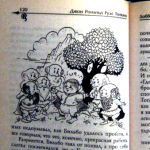 The book also includes some nice maps, such as this one of the Battle of Five Armies:
The book also includes some nice maps, such as this one of the Battle of Five Armies:  (You can see the arrows denoting where the orki are coming from.). Finally, one of the more disturbing pieces from the book are the elves which have wings. Yes, wings:
(You can see the arrows denoting where the orki are coming from.). Finally, one of the more disturbing pieces from the book are the elves which have wings. Yes, wings: 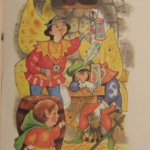 This is obviously the scene with Bilbo finding the way out of the Elven King’s halls through the empty wine barrels. But those wings… That’s a new one. Even so, it’s interesting to get a new perspective on the adventures of Бильбо БÑггинÑ, ГÑÌндальф, Торин and all the rest.
This is obviously the scene with Bilbo finding the way out of the Elven King’s halls through the empty wine barrels. But those wings… That’s a new one. Even so, it’s interesting to get a new perspective on the adventures of Бильбо БÑггинÑ, ГÑÌндальф, Торин and all the rest.
New Additions to the Library (Finally)
I have finally made some long overdue additions, corrections, and overall housekeeping to The Conlanger’s Library. You can see the primary ones on the “Most Recent Updates” block on the homepage. I have a number of other things I’d like to do to the Library’s overall look, etc., but we gotta start somewhere.
You’ll also notice that the countdown to St. Hildegard’s Day is at 70 days. I had made a St. Hildegard’s resolution last year, so we’ll see if I can fulfill that. I do have a new Kryslan blog that I can use for information on Dritok. We’ll see if the Fates are kind.
Happy conlanging!
California Conlangin’
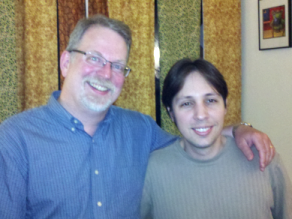
Two weekends ago, I was in California for the ALA Annual Conference (as part of my day-job not as Secretary-Librarian of the LCS) and had the chance to hang out a couple evenings with my friends David Peterson, his wife Erin, and Sylvia Sotomayor. Yes, that David Peterson. It had been well over a year since I saw David and Sylvia, and I hadn’t seen Erin since LCC2 back in 2008. It was great, and I’ve been remiss about thanking them all for a wonderful time. The first evening, after dinner at a nice little sushi place, the four of us stopped at the grocery store and picked up various sorbets, ice cream, and “chocolate covered honeycomb.” Decadent! Unfortunately, Sylvia had a long drive back home so I only got to see her one evening.
David and Erin, once they found out that I had never partaken of the experience that is In-N-Out Burger, offered to go out to supper the following evening with me. So, the next evening, David, Erin, and I piled into David’s natural-gas-powered car and rode over to In-N-Out Burger to order our repast. So, back at Erin and David’s then I experienced my first Double Meat, Animal-style, “Lemon-Up”, and fries. None too shabby (although Erin and David gave the meal a “B”… They’re In-N-Out connoisseurs) although I think I’m still a Five Guys guy, which is good since we don’t have any In-N-Out’s where I live.
It was great to hear stories from David and Erin about meeting Jason Momoa and his wife, Lisa Bonet, and other Game of Thrones tales.
With the work that David’s done with Dothraki, I cannot wait until Syfy’s Defiance begins next year! According to the news release in April, David is “alien language and culture consultant.”
I don’t get to hang out with my California conlanging cohort very often, but I have always been welcomed and feel fortunate to be able to be involved with them in the LCS. So, once again, thanks for a great time, for introducing me to In-N-Out Burger, and for sharing some of your valuable time with me. Dothras chek!
Spellwright: A Conlanger’s Review
I just finished Spellwright by Blake Charlton (Tor, 2010) 

 . The story follows the adventures of Nicodemus Weal, a “spellwright” who can’t spell. The most fascinating thing about the world that Blake Charlton has created is his novel system of magic where spells are formed within one’s body or peeled from the pages of a book. The master wizard, Agwu Shannon, is a great well-rounded character and could probably have sustained a book of his own. There are lots of other secondary characters and intriguing plots. But, since this is a conlanging blog, let’s see how Charlton handles language.
. The story follows the adventures of Nicodemus Weal, a “spellwright” who can’t spell. The most fascinating thing about the world that Blake Charlton has created is his novel system of magic where spells are formed within one’s body or peeled from the pages of a book. The master wizard, Agwu Shannon, is a great well-rounded character and could probably have sustained a book of his own. There are lots of other secondary characters and intriguing plots. But, since this is a conlanging blog, let’s see how Charlton handles language.
The first thing to know about language in the world of Nicodemus Weal is that language is Power…literally. The magical languages include Common, Numinous, Magnus, Wrixlan, Pithan, and the all-mighty Language Prime. One could think of these magical languages almost as computer code or prose. One who knows one of these languages can form the sentences, phrases, and paragraphs within their bodies and construct wonder-working spells. But be careful of misspellings! They can kill you. That is Nicodemus’ problem. He is a cacographer or one who is magically dyslexic, inadvertently misspelling even the simplest of spells.
To followup on the idea of writing instructions out of magical languages: In one section, a “bookworm” (a monstrous creature that eats magical texts or “malicious language that invades manuscripts. They eat all the prose and use it to make copies of themselves”) is caught and its text is parsed to figure out where it was supposed to return (i.e., it’s been programmed and its captors are going to re-program it). The book even describes “textual intelligence” as a required string of instructions: “if this happens, then do that; if that does not happen, then do this…”
The way Charlton described the magical languages is very evocative:
- “A sudden, golden jet of Numinous prose exploded…
- “…a bookshelf burst into a molten ball of silvery Magnus.”
- and maybe the best: After a struggle, someone’s face is “crushed by blunt words”
And since these languages all have writing systems to go with them, this could be a hey-day for some inventive con-scripter!
Humans are the primary beings in this world, but there are a Chthonic non-human people who dwelt in the land prior to humans’ arrival. We get one word of their language: tulki = masculine form of “interpreter”.
Charlton also has some fun with the word ghostwriting which is the spell a spellwright can use to exist after death.
Finally, we get the name of a few spells: madide, latere, sceaduganga. The last one, as I read, triggered some sort of Old English ancestral memory or something. So, I set off to check my available online Old English dictionaries. Sure enough, sceadu-genga occurs in Line 703 of Beowulf: Cóm on wanre niht / scrÃðan sceadugenga “In the colourless night, came / slinking the shadow-wanderer. (Click here for a good online Beowulf in Old and Modern English). The spell does indeed allow one to walk in the shadows or, in other words, to become invisible.
So, Spellwright is worth the read. A fascinating magical system, playful use of language, and interesting characters. It does drag a bit in spots being a little overly-reliant on exposition, but the action and overall story make up for these shortcomings. In fact, I thought (after reading it) maybe we should refer to ourselves as langwrights instead of conlangers. Just an idea.
